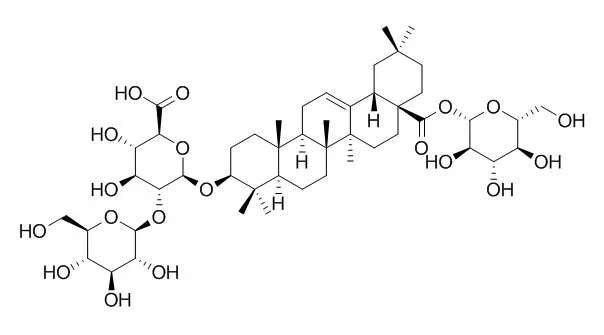| Animal Research: |
| Chinese Journal of Natural Medicines, 2015, 13(4):283-9. | | Ginsenoside Ro suppresses interleukin-1β-induced apoptosis and inflammation in rat chondrocytes by inhibiting NF-κB.[Pubmed: 25908625] |
METHODS AND RESULTS:
This study investigated effects of Ginsenoside Ro (Ro) on interleukin-1β (IL-1β)-induced apoptosis and inflammation in rat chondrocytes. The rat chondrocytes were co-treated with IL-1β (10 ng·kg(-1)) and Ro (50, 100 and 200 μmol·L(-1)) for 48 h. Chondrocytes viability was detected by the MTT assay and Annexin V-FITC/PI dual staining assay. Caspase 3 activity was measured by using caspase 3 colorimetric assay kit. Apoptosis related proteins Bax, Bad, Bcl-xL, PCNA, p53 and phospho-p53, along with inflammation related protein MMP 3, MMP 9 and COX-2, and the expression of phospho-NF-κB p65 were assayed by western blotting analyses. Ro could improve IL-1β-induced chondrocytes viability. Ro could suppress IL-1β-induced apoptosis by inhibiting levels of Bax and Bad, decreasing p53 phosphorylation and promoting the expression of Bcl-xL and PCNA. Ro inhibited caspase 3 activity. IL-1β-induced inflammation and matrix degration were also alleviated by Ro with down-regulating the expression of MMP 3, MMP 9 and COX-2. Moreover, Ro inhibited NF-κB p65 phosphorylation induced by IL-1β.
CONCLUSIONS:
In conclusion, these results suggested Ro exerted anti-apoptosis and anti-inflammation in IL-1β-induced rat chondrocytes, which might be related to NF-κB signal pathway. Therefore, we propose that Ro might be a potential novel drug for the treatment of osteoarthritis. | | Phytother Res. 2012 Jan;26(1):48-53. | | Effects of ginseng rhizome and ginsenoside Ro on testosterone 5α-reductase and hair re-growth in testosterone-treated mice.[Pubmed: 21538628] |
METHODS AND RESULTS:
This research program on the novel functions of Panax ginseng C. A. Meyer focused on the effects of ginseng rhizome on hair re-growth in androgenetic alopecia. Extracts of red ginseng rhizome showed greater dose-dependent inhibitory effects against testosterone 5α-reductase (5αR) when compared with extracts of the main root. Ginsenoside Ro, the predominant ginsenoside in the rhizome, and ginsenoside Rg(3), a unique ginsenoside in red ginseng, showed inhibitory activity against 5αR with IC(50) values of 259.4 and 86.1 μm, respectively. The rhizome of P. japonicus, which contains larger amounts of Ginsenoside Ro, also inhibited 5αR. Topical administration of extracts of red ginseng rhizomes (2 mg/mouse) and Ginsenoside Ro (0.2 mg/mouse) to shaved skin inhibited hair re-growth suppression after shaving in the testosterone-treated C57BL/6 mice.
CONCLUSIONS:
These results suggest that red ginseng rhizomes containing both oleanane- and dammarane-type ginsenosides are a promising raw material for cosmetic use. This is the first report that Ginsenoside Ro enhances in vivo hair re-growth based on their inhibitory activity against 5αR in the androgenetic alopecia model. |
|






 Cell. 2018 Jan 11;172(1-2):249-261.e12. doi: 10.1016/j.cell.2017.12.019.IF=36.216(2019)
Cell. 2018 Jan 11;172(1-2):249-261.e12. doi: 10.1016/j.cell.2017.12.019.IF=36.216(2019) Cell Metab. 2020 Mar 3;31(3):534-548.e5. doi: 10.1016/j.cmet.2020.01.002.IF=22.415(2019)
Cell Metab. 2020 Mar 3;31(3):534-548.e5. doi: 10.1016/j.cmet.2020.01.002.IF=22.415(2019) Mol Cell. 2017 Nov 16;68(4):673-685.e6. doi: 10.1016/j.molcel.2017.10.022.IF=14.548(2019)
Mol Cell. 2017 Nov 16;68(4):673-685.e6. doi: 10.1016/j.molcel.2017.10.022.IF=14.548(2019)